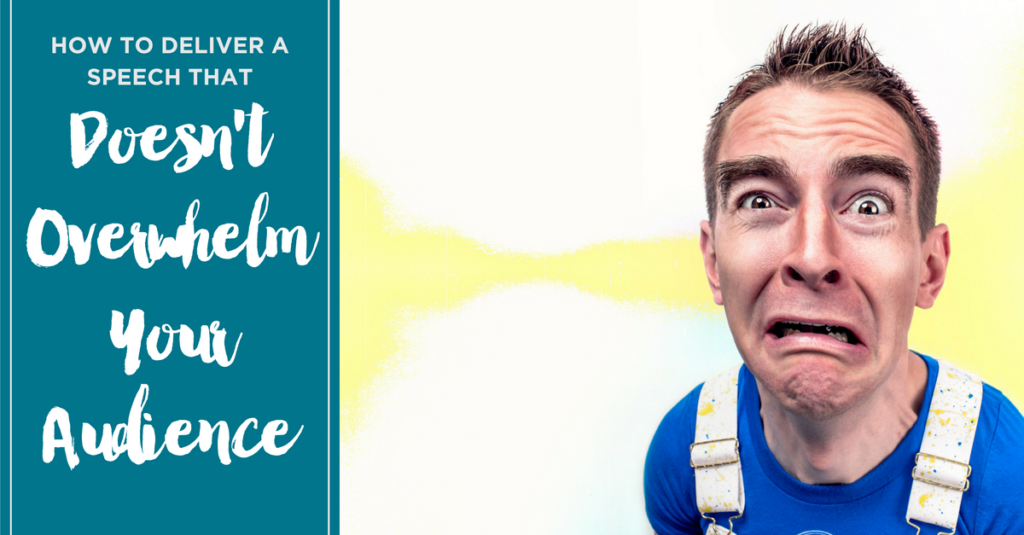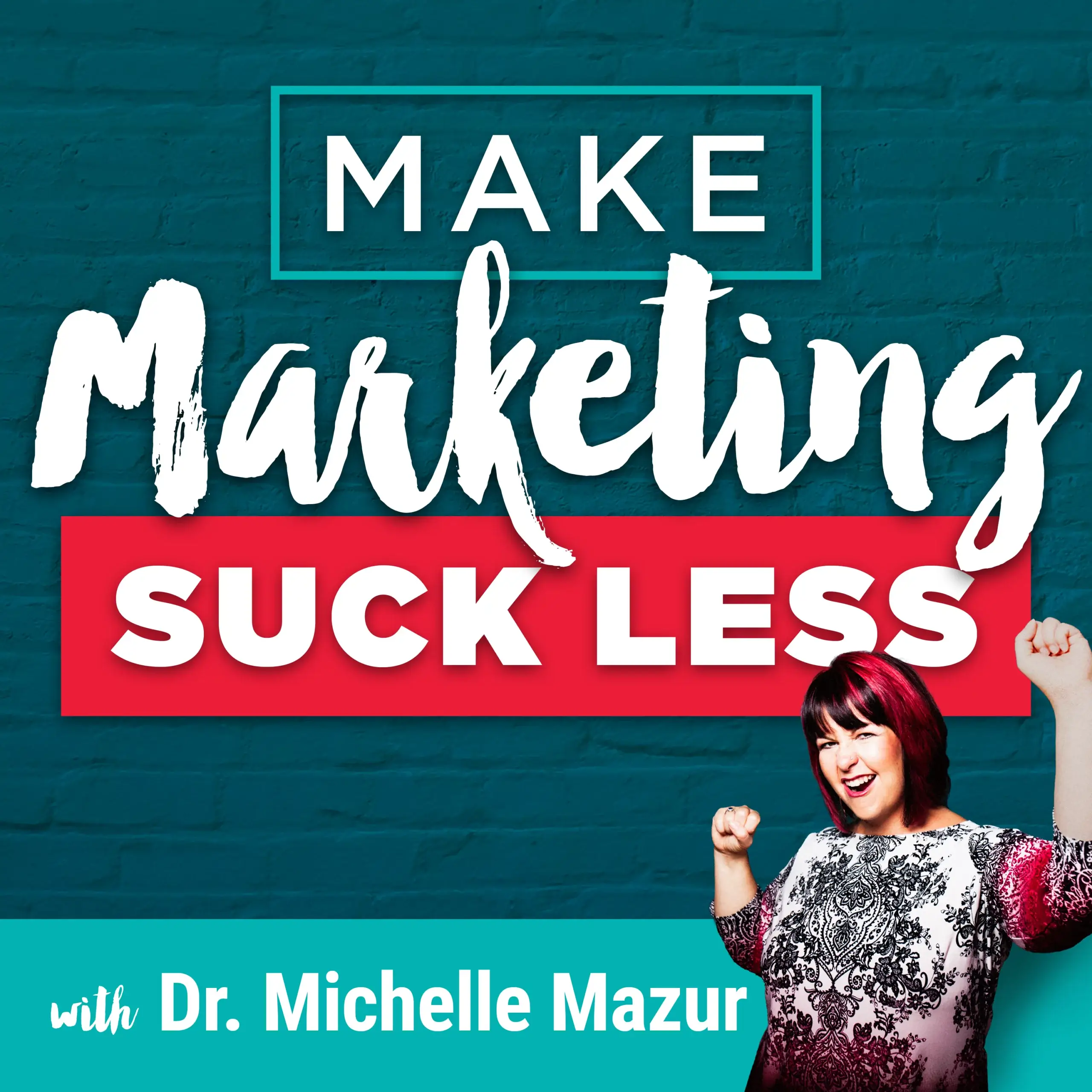Make Marketing Suck Less
How to Deliver a Speech that Doesn’t Overwhelm Your Audience
By Michelle Mazur > November 29, 2016
Filed Under Communication

Even though one is the loneliest number, it’s the only one you should have in mind when you deliver a speech that won’t overwhelm your audience. You need ONE BIG IDEA.
I know you’re brilliant. You want to share all of your innovative ideas and thoughts with your audience. And I know you know quality is better than quantity. . .am I right!?
So, why is it that I every time I turn around, speakers are spewing on their audiences?
It’s your reputation for over achieving, isn’t it? You’re an expert. You’re excited to share.
And one sounds so. . .lonely. So underwhelming. It feels like you’re not giving enough. Bigger is better, right?
Not always, and it’s certainly not better when we’re talking about how to deliver a speech.
Let’s get down to basics and learn how to deliver a speech that doesn’t overwhelm your audience.
Crunch the Numbers
I know you don’t come to me to learn about basic math principles, but in this case, they help me prove my point.
I’ve seen speakers try to cover:
- 5 tips during a 20-minute presentation {less than 4 minutes per tip since the talk—as all should—had an intro and a conclusion}
- 10 tips in a 45-minute talk {4.5 minutes per tip. . .you know that didn’t happen}
- 18 ways to start a revolution in a 2-hour workshop. . .You had me at 3 and I’m still wondering if I can accomplish it all! {Cray cray all the way!}
Even though I enjoy math as much as a root canal,“ew”, and understand why you might feel the same, you gotta DO.THE.MATH.
When I prepare a speech, I use the 10-10-80 rule {10% of the time is for the intro, 10% for the conclusion and the remaining 80% for the bulk of the speech}.
For a 20-minute talk, this equates to a 2-minute intro, 2-minute conclusion and 16 minutes for the body of the speech. Keep this formula in mind when you craft your speech to understand what you can cover in the allotted time.
Guide Your Audience
I understand why you’re drawn to the list format, because that’s what we see every day in blog posts we read. But your speech is not a blog post, and when it’s crafted like one it leaves the audience out of the picture.
When people read a blog post, they control the delivery. They can go back and re-read a complex thought. They can skim and seek out headers that intrigue them.
When we read, we control the cadence. . .you slow down for something confusing or interesting, speed up or skip it altogether if you’re falling asleep. You can even skip ahead!
The audience can’t control the flow of information in a speech.
They count on you, as the speaker, to understand what they need to make it easy to process, understand, and take action on your message. Be a trusted guide for your audience.
Too often, we fear the pause.
We feel compelled to FILL EVERY MOMENT. Your audience needs time to ponder and to integrate your compelling words.
Don’t leave your audience overloaded and confused. Allow time for your audience to process the information you share.
[Tweet “Speakers: Don’t fear your ONE BIG IDEA!”]
How to Deliver a Speech with One Big Idea
An easy way to be your audience’s trusted guide, is to distill your talk to the ONE BIG IDEA that you want them to remember.
This is what you want to be known for as a speaker. If a member of the audience told a friend about your speech, what is the ONE MESSAGE you would want them to spread? Your BIG IDEA should be simple, succinct and specific.
Stop overwhelming your audience and amp up your presentation with these 3 tips:
- Understand your audience: Of all the big ideas swimming around in your head, which ONE is best suited for what your audience needs NOW?
- Make time for reflection and integration: The magic happens when your audience has time to absorb the message you are sending.
- Create action from your information: Help your audience understand how they can take action. Don’t leave them confused about the next step.
Erica Loren, a certified coach and expert in positive psychology, had been speaking for years and crafted a signature talk that just wasn’t hitting the mark.
When we first met, I knew that an audience would quickly resonate with her energy and enthusiasm.
It became clear as we worked together in my Speak for Impact program, that her speech was missing a BIG IDEA. After we worked together, here’s how her audience reacted to her ONE BIG IDEA that we crafted together:
“I got immediate feedback on my BIG IDEA! While I was still talking, pens were frantically writing the phrase ‘Happiness is not a luxury, it’s a mission critical work ethic.’ Then, after my speech, I was inundated with excited people sharing how my BIG IDEA had immediately impacted their thinking, and what a breakthrough it was for them.”
Don’t fear your ONE BIG IDEA.
I promise you won’t disappoint your audience. Rather than delivering too little, your words will resonate and be more impactful than ever before when you distill your thoughts into the ONE BIG IDEA you want to be known for.
Audiences want to integrate your message. Be a trusted guide and help them!
Create Your One-of-a-Kind Message
Your 3 Word Rebellion is the Key to Growing Your Business & Impact






